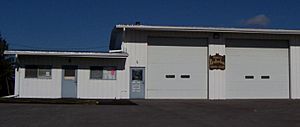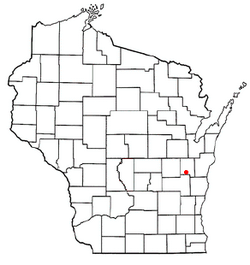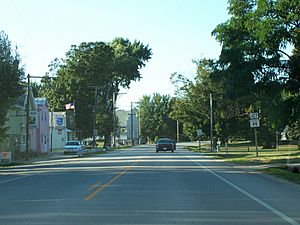Brothertown, Wisconsin facts for kids
Quick facts for kids
Brothertown, Wisconsin
|
|
|---|---|

Town hall
|
|

Location of Brothertown, Wisconsin
|
|
| Country | |
| State | |
| County | Calumet |
| Area | |
| • Total | 54.5 sq mi (141.2 km2) |
| • Land | 36.6 sq mi (94.8 km2) |
| • Water | 17.9 sq mi (46.4 km2) |
| Elevation | 984 ft (300 m) |
| Population
(2020)
|
|
| • Total | 1,328 |
| • Density | 24.359/sq mi (9.405/km2) |
| Time zone | UTC-6 (Central (CST)) |
| • Summer (DST) | UTC-5 (CDT) |
| Area code(s) | 920 |
| FIPS code | 55-10350 |
| GNIS feature ID | 1582873 |
Brothertown is a small town in Calumet County, Wisconsin. It's located in the United States. In 2020, about 1,328 people lived here. This was just a tiny bit less than the 1,329 people who lived there in 2010.
Several smaller communities are part of the town of Brothertown. These include Brothertown (the community), Charlesburg, Eckers Lakeland, Jericho, and Maple Heights. Part of Calumetville is also in the town.
Contents
History of Brothertown
The town of Brothertown has an interesting past. It was once home to the Brothertown Indians. These Native American people moved to this area from New York between 1831 and 1836.
The town was officially created on March 21, 1843. Back then, it was called "Manchester." For a short time in the early 1850s, it was also known as "Pequot" or "Sequoit." The local post office was even called "Pequot" in 1841. Finally, on May 4 or 5, 1857, the town was renamed "Brothertown."
Geography of Brothertown
Brothertown is located in the southwest part of Calumet County. A big part of the town, about one-third of its western side, is actually in Lake Winnebago.
The town shares its borders with other counties. To the west, you'll find Winnebago County. To the south, it borders Fond du Lac County. A major road, U.S. Route 151, runs through the western side of the town. It passes right through the community of Brothertown.
The total area of the town is about 141.2 square kilometers (54.5 square miles). Out of this, 94.8 square kilometers (36.6 square miles) is land. The rest, about 46.4 square kilometers (17.9 square miles), is water. This means about 32.83% of the town's area is covered by water.
Who Lives in Brothertown?
In 2000, there were 1,404 people living in Brothertown. These people lived in 523 homes, and 380 of those were families. Most people living in the town were White (99.79%).
About 33.3% of the homes had children under 18 living there. Most homes (63.3%) were married couples living together. About 23.1% of all homes were single individuals. Also, 8.0% of homes had someone 65 years old or older living alone. On average, there were 2.68 people in each home and 3.19 people in each family.
The people in Brothertown are of different ages. About 27.3% were under 18 years old. About 11.5% were 65 years old or older. The average age in the town was 37 years.
Schools in Brothertown
Students in Brothertown attend schools in different districts. The town is part of the New Holstein school district. It is also part of the Chilton school district. For higher education or job training, students can go to Moraine Park Technical College or Fox Valley Technical College.
Local News
The official newspaper for the town of Brothertown is the Chilton Times-Journal. Important public notices for the town are posted in a few places. You can find them at the town hall on St. Charles Road. They are also posted at Pete's Fisherman's Inn in Brothertown. Another place to find notices is outside the old Roman Catholic Church in Charlesburg.
See also
 In Spanish: Brothertown (Wisconsin) para niños
In Spanish: Brothertown (Wisconsin) para niños


